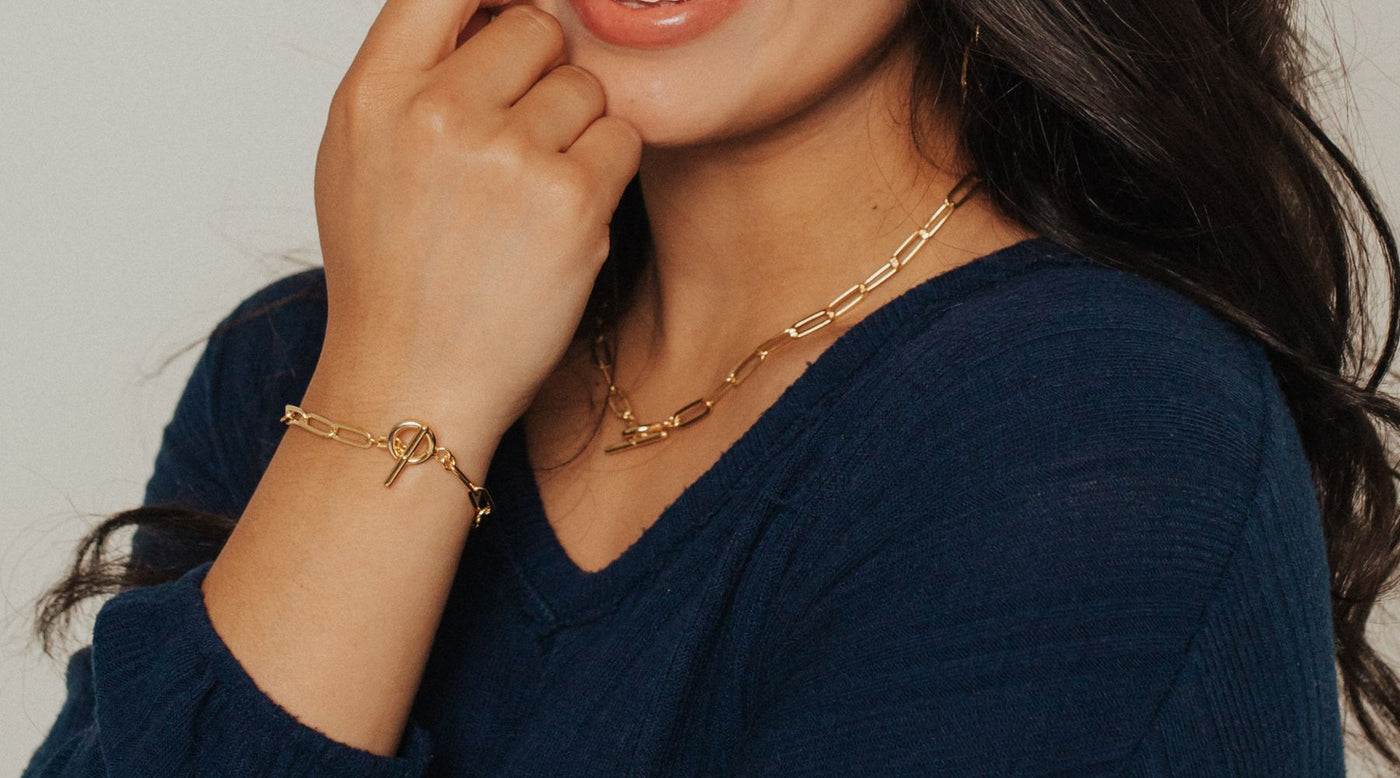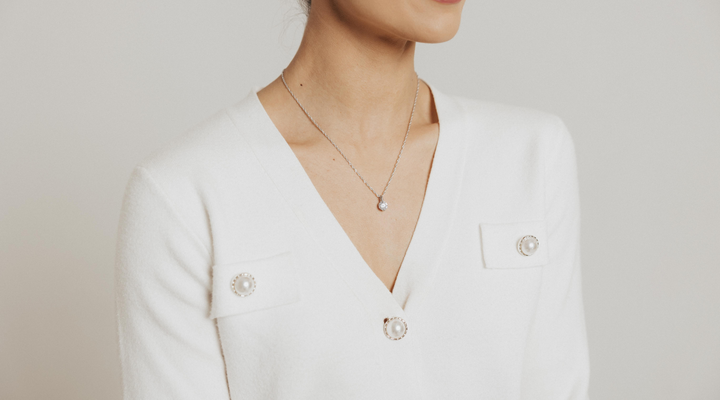The Ultimate Guide on How to Purchase Jewelry for Your Collection
Posted by Deven Davis on

Keyword(s): how to purchase jewelry
Putting a fashionable piece of jewelry on can instantly transform your outfit from blah to gorgeous. It doesn't even need to be a statement piece of jewelry, just well-chosen.
That's why purchasing jewelry is both an art and a science. Whether you're a novice collector or an experienced aficionado, acquiring pieces that hold both aesthetic value and financial worth requires knowledge, strategy, and a discerning eye.
This ultimate guide will explain how to purchase jewelry, from understanding different types of jewelry and their value to making informed decisions and building a cohesive jewelry collection.
Understanding Different Types of Jewelry
If you have been purchasing jewelry for a while now, you might have a preference with regard to the kind of jewelry you invest in. There are three kinds to choose from in the market, broadly speaking.
1. Fine/Classic Jewelry
Fine jewelry is made from precious metals such as gold, platinum, and silver, often adorned with genuine gemstones like diamonds, sapphires, rubies, and emeralds.
These pieces are designed to last a lifetime and can be passed down through generations. Fine jewelry retains its value well, making it a solid investment. You might have a few pieces like this in your family as well - pieces that you are planning to give to your daughter or granddaughter one day in the future.
2. Semi-Fine Jewelry
Semi-fine jewelry is crafted from precious and semi-precious materials but may include lower-karat gold or gold-plated metals and lesser-known gemstones. While not as valuable as fine jewelry, semi-fine pieces offer good quality and craftsmanship at a more accessible price point.
3. Costume Jewelry
Costume jewelry is made from base metals and imitation stones, designed primarily for fashion and affordability rather than long-term value. These pieces are ideal for following trends and adding variety to your collection without a significant financial commitment.
But remember that these pieces are sometimes made from shoddy material that could be toxic to the body, as they fall into the "fast fashion" category. They are also not great for the environment.
Researching Jewelry Trends and Timeless Styles
Understanding current jewelry trends and timeless styles can help you make informed decisions. While trends come and go, certain styles remain perennial favorites. Researching both can ensure your collection has a mix of contemporary and classic pieces.
Of course, this doesn't mean that you should get stuck within a certain trend and not budge from it. Personal fashion is all about doing what your heart desires rather than what the media dictates.
You should also be comfortable in these jewelry pieces, not feeling overwhelmed by them.
1. Current Trends
Stay updated with the latest jewelry trends by following fashion magazines, online blogs, and social media influencers. Popular trends might include specific gemstone cuts, metal finishes, or design themes like minimalism or vintage-inspired looks.
2. Timeless Classics
Investing in timeless pieces, such as diamond studs, pearl necklaces, or simple gold bands, ensures that your collection retains its appeal regardless of changing trends. These classics can be worn for various occasions and often hold their value well.
Evaluating Quality and Authenticity
Ensuring the quality and authenticity of your jewelry is crucial, especially when purchasing fine or semi-fine pieces. You can avoid this conundrum by purchasing from a well-known reputable manufacturer like Roma Designer Jewelry.
Here are key factors to consider:
1. Material and Craftsmanship
Examine the materials used in the jewelry, including the type and purity of metal and the quality of gemstones. Look for hallmarks or stamps indicating metal purity, such as "18K" for 18-karat gold. Assess the craftsmanship by checking for secure settings, smooth finishes, and overall symmetry.
2. Certification and Appraisal
For fine jewelry, particularly pieces with significant gemstones, request certification from reputable organizations like the Gemological Institute of America (GIA) or the American Gem Society (AGS). These certificates provide detailed information about the gemstone's characteristics and authenticity. Additionally, consider getting an independent appraisal to determine the piece's current market value.
Choosing the Right Retailer
Selecting a trustworthy retailer is crucial to ensure you receive quality pieces at fair prices. Consider the following when choosing quality jewelry and where to purchase your jewelry.
1. Reputation and Reviews
Research retailers' reputations by reading customer reviews and seeking recommendations from trusted sources. For example, your friends or loved ones might have jewelers that they trust and always use.
Don't follow their recommendations blindly though. Pick some of the recommended jewelers and go visit them in person to satisfy yourself.
Established jewelers with a long history of satisfied customers are often more reliable.
2. Return Policy and Warranty
Review the retailer's return policy and warranty options. A flexible return policy allows you to return or exchange pieces that don't meet your expectations.
Warranties provide protection against defects and potential damages. You want to choose a jeweler who stands by his/her products.
3. Specialized Expertise
Choose retailers that specialize in the type of jewelry you're interested in. For example, some jewelers may have extensive expertise in antique or vintage jewelry, while others might focus on contemporary designs or custom pieces.
This depends highly on what kind of pieces you are searching for. Perhaps you have an exact idea of what you want. That's when specialized jewelers will come into play.
Making Informed Purchases
When purchasing jewelry, taking a methodical approach can help you make informed decisions and avoid buyer's remorse. Just like you would spend hours or even days when it comes to making a big purchase, like an appliance or a car, the same applies to jewelry as well.
1. In-Store Purchases
When buying in-store, take the time to examine the pieces closely. Ask the jeweler questions about the materials, craftsmanship, and any available certifications. Try on the jewelry to ensure it fits well and complements your style.
2. Online Purchases
Online shopping offers convenience and a wide selection, but it also requires careful consideration. Ensure the website is reputable, and read the product descriptions thoroughly.
Look for high-resolution images and, if possible, customer reviews of the specific piece you're interested in. Verify the site's return policy in case the jewelry does not meet your expectations upon arrival.
Building a Cohesive Collection
As you acquire more pieces, aim to build a cohesive collection that reflects your personal style and preferences. Remember, Rome wasn't built in a day, and neither will your jewelry collection. You will keep adding and subtracting from your collection as time goes on.
Here are some tips for creating a well-rounded jewelry collection.
1. Variety and Versatility
Include a variety of pieces in your collection, such as necklaces, bracelets, rings, and earrings. Choose versatile pieces that can be mixed and matched to create different looks for various occasions.
2. Balance Between Trends and Classics
Maintain a balance between trendy items and timeless classics. Trendy pieces add excitement and contemporary flair to your collection, while classic items provide enduring value and elegance.
3. Personal Touches
Select pieces that hold personal significance or resonate with your individual taste. Jewelry can be a reflection of your personality, milestones, and memories, making your collection unique and meaningful.
Caring for Your Jewelry
Proper care and maintenance are essential to preserve the beauty and longevity of your jewelry. Even if your pieces aren't that expensive, that doesn't mean you can ignore or neglect them.
Here are some tips for keeping your collection in pristine condition:
1. Regular Cleaning
Clean your jewelry regularly to remove dirt, oils, and residues that can dull its appearance. Use appropriate cleaning methods for different materials.
- Gentle soap and water for gold
- Specialized cleaners for diamonds
- Soft cloths for pearls
Speak to the jeweler about how to clean your specific piece of jewelry when you purchase it. This way you will be prepared for the future.
2. Safe Storage
Store your jewelry in a safe, dry place. Use individual compartments or soft pouches to prevent pieces from scratching each other. For fine jewelry, consider a secure jewelry box or safe.
3. Professional Maintenance
Schedule professional maintenance for your jewelry, especially for fine pieces. Regular inspections by a jeweler can identify and address potential issues, such as loose settings or worn prongs before they cause significant damage. The more you give to your jewelry, the more it will give back to you.
How to Purchase Jewelry - Take Your Time and Do It Well
Don't be overwhelmed by all the steps on how to purchase jewelry laid out in the article above. You are not going to become an expert in choosing quality jewelry in a day or two.
That's why picking the right jeweler is so valuable in this day and age. Roma Designer Jewelry scours the world to bring the finest materials, designs, and craftsmen to you. Check out our unique and timeless jewelry collection, all at price points that make it fair for all involved.













